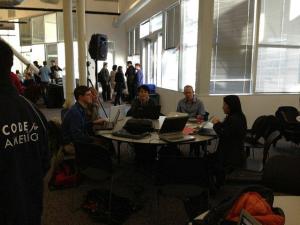I often say that when it comes to K-12 learning technologies, we need lots of innovators working in different ways on the same opportunities. My team and I believe this can help speed up the innovation cycle for lots of great, affordable solutions aimed at tough instructional challenges.
Grant-makers, including my team at Gates, often strive to fund the “best” intervention with hopes it will produce results and be able to “go to scale.” But this needle in a haystack approach can be ineffective when it comes to early stage learning technologies. New applications and tools are rarely “right” from the beginning. They need time for testing with users and room for shifts in functionality and business model. Philanthropy can have the unintended consequence of buffering entrepreneurs from the natural give and take between product developers and customers that makes solutions better.
That’s why we’re trying to spend more of our time and capital on increasing the number of needles in the haystack so they are easier to find. I’m not sure this haystack analogy works, though I promised myself I’m not going to edit these posts much. But you get the picture. Rather than always looking for THE solution, we’re trying to figure out ways to strengthen incentives for lots of players to tackle tough problems, trusting that in the long-run customers will pick the winners based on what works. I talked with edsurge about this a few months ago and will share more of what we’re thinking and doing on this front on this blog over the next few months.
One of the projects we’ve been working on with partners for a couple of years is the Shared Learning Collaborative. We’re funders and I chair the board. The project is complicated, but one of my favorite descriptions shows how the SLC tech services help Mr. Thompson, a fake middle school math teacher, personalize learning for his students.
Though good ol’ Mr Thompson is fake, the scenario he represents is very real. By working with partners to solve key pain points at the infrastructure level, the SLC aims to create more incentives for innovation in applications that help personalize and accelerate learning for students. At this point we’ve talked with around 1000 educators about what they need from instructional technologies. One thing we heard loud and clear is that many applications don’t take into account the reality of the classroom — which problems are most important, how kids and teachers interact, what resources they have available.
So, we are working to link teachers more closely with developers & entrepreneurs who want to put their creativity and talent to work on solutions that matter most for kids and teachers. In that spirit, over the weekend I was in Silicon Valley at SLC Camp with 300 educators and developers who formed teams to generate ideas and translate them into prototype apps over about 30 hours. Here’s a team of teachers and developers at work on their idea:
At the end of the weekend, seven teams of educators and developers pitched their ideas and demo-ed their prototypes. Three won cash prizes. I’ll do a short post later in the week with brief descriptions of the winners. In the meantime, let me know what you think about our intention to spend more time on strengthening incentives for lots of innovators and creating better connections between teachers and product developers.
